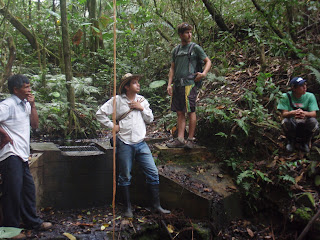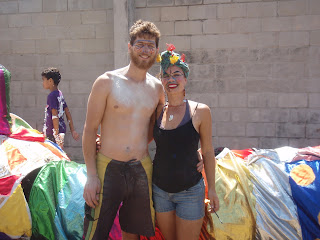It was difficult to get on the road again
after spending so long at La Fruta. When
we arrived in Santa Marta Carolina Medellin
They were glad to have us back, and the
event proved another ‘lucky mishap’ on our path, as we were invited the
following evening to join Helmi and Carroll with their Shaman, John, to participate in a
ceremony in his 'casita' in the mountains.
We arrived around sunset, after walking up the dirt road, and collecting
wood for the fire for the evening. We
spent the night talking and meditating around the fire, enjoying the pristine
view of the Palomino
River Caribbean . The night was quite profound, especially for
Claire who really delved into herself and her relationship with the world, and
we left the next morning more in tune with ourselves, one another, nature, and
the road upon which we have embarked.
After that we finally did catch the bus to Medellin Medellin
After three days at La Mafafa, we returned
to civilization and the city of Medellin
After a few days in the city, we were
itching to move on to the South and resume our WOOFing at a Finca in San
Agustin, where we had agreed to start on the 1st of March. Unfortunately, (certainly, more for those
involved than for us), the main road south – and the only route by road to
reach neighboring Ecuador
It was hard not to feel a bit disappointed
– we had just had such profound experiences in the Sierra
Nevada , and we were eager to continue learning and
progressing. More time in the city is
not what we had expected. Once again,
the obstacle presented yielded a more brilliant result for Claire and I. A friend of Jason’s, named Viviana, told us
that she had a friend in the city with a sustainable farming project near Medellin
As we drove the winding, mountainous roads
west from Medellin Zambia
We arrived after dusk from a steep climb of
about 40 minutes, offering views which would have stolen our breath, if only we
could have caught it first. At nearly
6,000 feet, the community of La Cienaga was a big change from (easily) less
than 1,000 at La Fruta. We arrived first
at the house of Jaime’s parents, who offered us some wonderful food, cooked
over a wood stove with all the love of a warm home. We chatted a bit with Ruth and Hernando,
Jaime’s parents, and quickly found where he got his geniality and kindness. After dinner, we climbed to the project’s central
house, and met Gorge – the project director, a man who has more knowledge than
we could possibly hope to absorb, and the love and patience to teach it – and
Eihder – a Campesino of about our age with whom we quickly became friends. We
stayed up chatting for a bit, and then prepared to see La Cienaga the next day
in the daylight.
The following day we met the rest of the
community – about 6 or 7 families living relatively near each other, each with
their own garden and fields and tracts of land.
We quickly found the people incredibly amiable and eager to share. We had more smiles, food, and warm Agua
Panela than we could have hoped. We felt
immediately at home, and couldn’t help noticing the similarities between this
community, in the heart of Colombia Zambia
Of course, not all things in the Community
are so perfect. There are many problems mounting
because of the presence of a Canadian-owned Gold mine which is nearby, which
has (surprise, surprise) succeeded in polluting water supplies and brought
social problems regarding the employment, lodging, and integration of the
miners. Furthermore, illegal mining
activities at the mine seems, performed by women, children, and men all without
proper protection or tools, increase the already high danger of fatality or
injury in the mining area.
This lesson is one that has hit hard, but
as La Cienaga is removed from the mining, we have not witnessed it with our own
eyes – only through the sorrowful words of the friends we have made here. However, another environmentally destructive
practice has been more evident. The
second day here, we went walking up the mountain to find sources of water – it
seems that water has been incredibly short for the communities further down the
mountain in recent years. The area of La
Cienaga was once a cloud-forest (paramo), meaning that while there were not
always periods of rain, the forests were able to trap and absorb moisture from
the clouds, and thus return it to the soil and streams of the area. When we climbed to the top of the mountain,
we huge tracts of land felled completely of trees in order to open space for
grazing cattle. Subsequently, the trees
can’t trap the moisture from the clouds, which now blow hastily over the peaks
without depositing the water so essential for the area’s survival. What makes matters worse is that the
‘gentleman’ who owns the land doesn’t live in the area, but rather in the city,
and in the fifteen years since the trees have been cut, not a cattle has been
seen on the barren slopes.
How anyone could act with such callousness
and insensitivity to nature is difficult to comprehend. How anyone could do so with the knowledge
that this action would negatively affect hundreds of people and leave them
without their basic needs of survival is inexcusable. But, after all, it is ‘his land’…
Luckily, projects like the one that Jorge,
Jaime, and Eihder are working on are offering a different, more reasonable way
forward. The group found another water
source nearby (apparently with a more sensible owner, who left trees to gather
water), and some of the water in the stream will be rerouted to offer water to
the parched riverbeds below the clear-cut.
Hopefully, this will hold the community over until the rains fall again.
Working with Jorge and Eihder, and spending
time with the other families in La Cienaga, has taught us an incredible amount
about the humility and knowledge of the people here, as well as lots of
practical knowledge about organic agriculture.
We have been working in the gardens and fields, as well as spending time
preparing and processing seeds and roots which have been used ancestrally but
recently forgotten in the community. In
order to restore enthusiasm in these practices, Claire has been using the oven
at the house (did I mention we have electricity!?) to combine creative recipes
and love to offer some unique cookies with truly distinct ingredient variations
including Quinoa, Chia, Amarantho, Achira, and other native grains.
Throughout this time here, we are
constantly grateful for being received so well, and being lucky enough to work
with and learn from such genuine, open, and caring people. Often, people within the community offer us
thanks for visiting with them and talking, and we feel a pang of guilt that we
can’t offer more than conversation, friendship and cookies, as these wonderful
friends have opened their homes and their hearts to us. I suppose we are still collecting positivity
and love from around the World, so that once we finally have a home, we can
open it to those who pass by with equal warmth, compassion, and freedom.



















